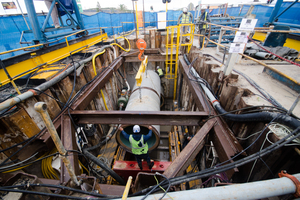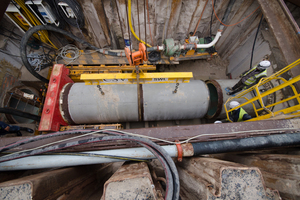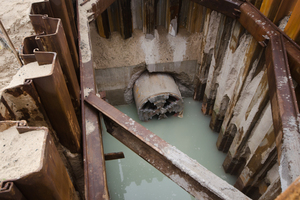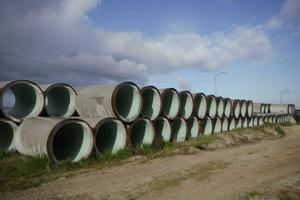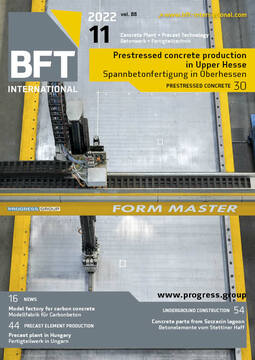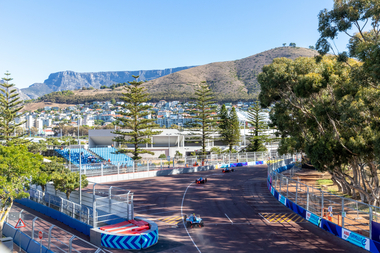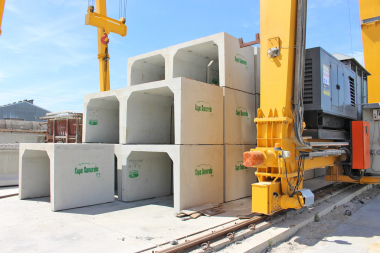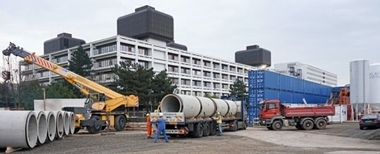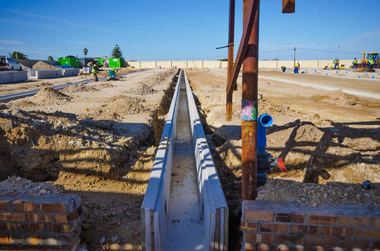Micro-tunneling ups safety in bulk sewer installation
CSV Construction has installed a 2,35km bulk sewer pipeline with state-of-the-art micro-tunnelling technology in Mitchells Plain, Cape Town. Acid-resistant HDPE-lined concrete pipes, manufactured by CMA member, Concrete Units, were used to construct the line, which was completed in June 2022. DoHS Farm694 – 2432m Bulk Sewer in Spine Road and Residential Area is a R300million Department of Human Settlements project. Once completed, ownership of the line will be transferred to the City of Cape Town.
The pipeline was built in two sections. The first, which was completed in March 2021, comprises a 1,05km line using 1 200mm ø x 2m long pipes. Starting from a manhole in Merrydale, it follows a servitude parallel to an existing bulk sewer line under residential properties and a school in Merrydale as well as under the neighbouring suburb of Rocklands to a point in Spine Road. The second section, which uses 1 350mm ø x 2,5m long pipes, runs for 1,3km along Spine Road and feeds into the Mitchells Plain Waste Water Works.
Herrenknecht AVN boring machines
The tender was put out as a conventional open-cut installation, but several conditions rendered this option more expensive, disruptive, considerably more time consuming and very high risk. These included: a sandy and water-logged terrain; pipeline depths of up to 9.0m; a first-section routing through built-up areas; and a routing along the centre of Spine Road.
“Therefore open-trenching wasn’t a viable option,” said Hannes Coetzee of CSV. “Various routes were considered but in the end, we opted to install the line next to an existing bulk sewer. During the early stages of the installation, we also discovered a bulk water main at a depth of four metres which was unknown at the tender stage and we managed to tunnel between it and the bulk sewer. In some instances, we were within 1,5m of the water line, but at an average depth of seven metres, our tunnel was consistently two metres deeper and well below all the other utilities.” CSV used two German-made Herrenknecht AVN boring machines for the tunnelling. Closed full-face excavation machines, they are built with hydraulic circuits for the removal of soil and can bore up to distances of 500m. “We installed the 1 200mm pipes in six drives of up to 180m each using our AVN 800mm MTBM (Micro-tunnelling Boring Machine) upsized to 1 200mm. The Spine Road section was executed in nine drives using the AVN 1 200mm MTBM, upsized to 1 350mm, also at drive lengths of up to 190m.
“The machines were equipped to handle the anticipated ground conditions based on a geotechnical survey of the designated route. No rock was found, merely small outcrops of calcrete and clay interspersed among the soft soil. This meant we were able to opt for our soft-soil cutting head, one of our three cutter-heads options.” A typical micro-tunnelling drive begins by sinking several launching shafts sequentially. Shaft walls are retained with steel sheet piling to the requiring depth, in this instance to between seven and nine metres, and a gantry is used to lower the boring machine and a hydraulic jack into the shaft. Twin pipe sections are attached to the rear of the AVN and, as drilling commences, the hydraulic jack pushes the linked pipe section and AVN into what becomes the bulk sewer line.
“The direction of the AVNs during drilling is controlled from a remote operating panel situated close to the launching shaft. It is fed with directional information from laser beams deployed inside the tunnel. This enables us to effect three-dimensional adjustments with articulated hydraulic rams attached to the AVNs’ cutting heads and gives us a directional tolerance of 15mm, well within the specified SANS standard of 50mm,” said Coetzee.
Pipes delivered by Concrete Units
Once drilling in both directions is completed a new launching shaft was sunk and the existing launching shaft and the two subsidiary shafts were used to construct the permanent manholes. Additional manholes were installed at pipe-sections’ mid-points by sinking intermediary shafts and cutting into the crown of installed pipes. In this way manholes were located at ±90m intervals. Using eight moulds, Concrete Units cast the pipes to a 100D strength rating to withstand extreme jacking forces. The pipes have a jointing system comprising a cast-in steel band and a sliding rubber ring which is not only watertight but allows for directional adjustments. Concrete Units manager, Charl Coetzee, said approximately 20m of pipe a day have been installed on this project. “Therefore, to maintain a steady supply we used eight moulds for the casting. Each pipe mould was measured before casting and the pipes were cast with a 3mm HDPE AKS lining made by AKAS lining systems in Cape Town,” said Coetzee.
AVN micro-tunnelling machines have three cutter head options depending on the expected geology, be it soft soils as in the case of the Michells Plain project, a combination of soft soils and hard rock, or solely hard rock. During tunnelling, a cone-shaped crusher in the excavation chamber crumbles rock and other material to a conveyable grain size; it is pumped out through the slurry line to a separation plant where the solids are removed and the water returned to the boring machine. Hannes Coetzee says micro-tunnelling is an environmentally-friendly system that protects developed and landscaped areas and minimises traffic disruption.
“With the rapid urbanization of our cities, coupled with ageing infrastructure, there is a growing need to install and upgrade bulk water and sanitation services. Trenchless technologies such as micro-tunnelling offer a safe, cost-effective and low-risk solution.
“It significantly reduces the risks often associated with conventional open excavations. These include public and worker safety, risk of damage to other existing utilities, as well as the risks associated to the client’s programme and budget. It also provides solutions in cases where conventional, open-trench pipe laying would simply not be possible.
“We believe the innovative solutions offered by trenchless technology should be considered and incorporated at the bulk water, stormwater and sanitation master-planning stage, and we would like to encourage municipalities to reach out and allow us to demonstrate how this innovative technology will assist them with upcoming projects.”
Text: David Beer
CONTACT
Concrete Units
Montreal Dr, Airport Industria
Cape Town/South Africa
+27 21386 1923

